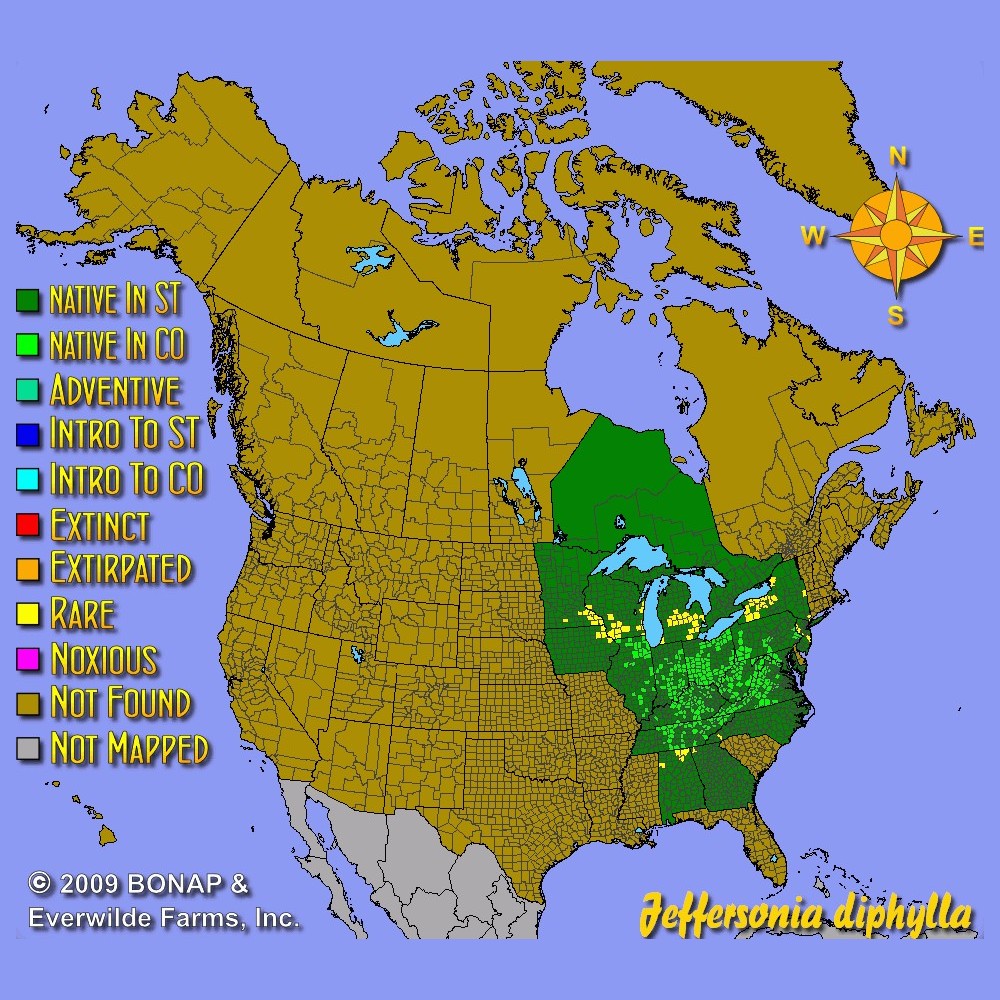Twinleaf Seeds
- HOW TO GROW
- FAST FACTS
- REVIEWS
HOW TO GROW
Sowing: To break their dormancy, these seeds need to experience cold and warm moist periods followed by another period of cold moisture. Mix the seeds with a small amount of damp sand and place in a sealed plastic bag; store in a refrigerator for 30 days, then at 70-75 degrees F for 30 days, with a final period of 30 days in the refrigerator. Sow the seed just below the surface of the soil in a germination flat, keeping the soil lightly moist and at room temperature until germination; since these plants resent having their roots disturbed, they should be transplanted outdoors as soon as they can safely be handled. Alternatively, this seed can be direct sowed outdoors in late fall and allowed up to two years to germinate.
Growing: Transplant seedlings after the last frost of spring; keep the soil consistently moist and free of weeds. This plant develops rather slowly, usually producing only a few leaves in its first year because of the growth of its extensive root system. Blooming usually occurs after 5-6 seasons of growth. Mature plants also grow best in moist soil, and will benefit from a mulch of leaves to conserve moisture and control weeds. Fully developed plants can easily be divided in late fall or early spring. Though it blooms in spring, this plant remains attractive until frost and can be used as an effective ground cover.
Harvesting: These blossoms do not perform well as cut flowers, and are best enjoyed outdoors.
Seed Saving: A few weeks after blooming, this plant will produce a rounded 1" pod with a top that eventually opens, spilling out shiny brown seeds. Collect the seeds as soon as they mature to a brown color. For best germination, plant the seed immediately or keep them moist in the refrigerator until planting.
FAST FACTS
Common Names: Helmet Pod, Ground Squirrel Pea
Latin Name: Jeffersonia diphylla
Species Origin: US Native Wildflower
Type: Native Wildflowers
Life Cycle: Perennial
USDA Zones: 5, 6, 7
US Regions: Midwest, Northeast, Southeast
Seeds per Ounce: 1,600
Stratification: Warm/Wet for 4 Weeks, then Cold/Wet for 4 Weeks
Germination Ease: Stratify 8 Weeks
Sunlight: Shade
Height: 9 Inches
Color: White
Bloom Season: Blooms Early Spring
Product review
Great service! Product packaging and seed info informative and helpful.
DESCRIPTION

HOW TO GROW
Sowing: To break their dormancy, these seeds need to experience cold and warm moist periods followed by another period of cold moisture. Mix the seeds with a small amount of damp sand and place in a sealed plastic bag; store in a refrigerator for 30 days, then at 70-75 degrees F for 30 days, with a final period of 30 days in the refrigerator. Sow the seed just below the surface of the soil in a germination flat, keeping the soil lightly moist and at room temperature until germination; since these plants resent having their roots disturbed, they should be transplanted outdoors as soon as they can safely be handled. Alternatively, this seed can be direct sowed outdoors in late fall and allowed up to two years to germinate.
Growing: Transplant seedlings after the last frost of spring; keep the soil consistently moist and free of weeds. This plant develops rather slowly, usually producing only a few leaves in its first year because of the growth of its extensive root system. Blooming usually occurs after 5-6 seasons of growth. Mature plants also grow best in moist soil, and will benefit from a mulch of leaves to conserve moisture and control weeds. Fully developed plants can easily be divided in late fall or early spring. Though it blooms in spring, this plant remains attractive until frost and can be used as an effective ground cover.
Harvesting: These blossoms do not perform well as cut flowers, and are best enjoyed outdoors.
Seed Saving: A few weeks after blooming, this plant will produce a rounded 1" pod with a top that eventually opens, spilling out shiny brown seeds. Collect the seeds as soon as they mature to a brown color. For best germination, plant the seed immediately or keep them moist in the refrigerator until planting.
FAST FACTS
Common Names: Helmet Pod, Ground Squirrel Pea
Latin Name: Jeffersonia diphylla
Species Origin: US Native Wildflower
Type: Native Wildflowers
Life Cycle: Perennial
USDA Zones: 5, 6, 7
US Regions: Midwest, Northeast, Southeast
Seeds per Ounce: 1,600
Stratification: Warm/Wet for 4 Weeks, then Cold/Wet for 4 Weeks
Germination Ease: Stratify 8 Weeks
Sunlight: Shade
Height: 9 Inches
Color: White
Bloom Season: Blooms Early Spring
Reviews
Review
Product review
Great service! Product packaging and seed info informative and helpful.





